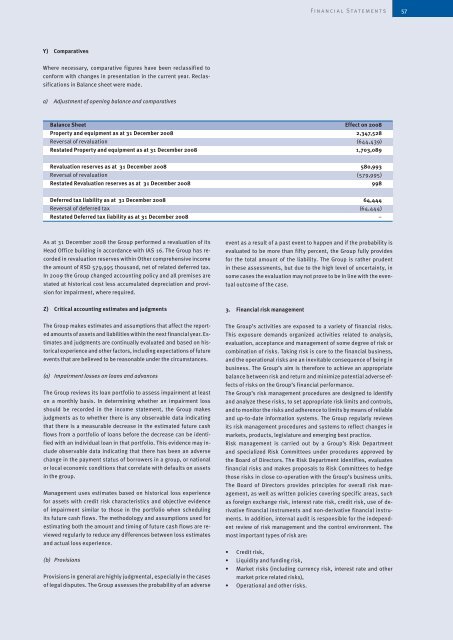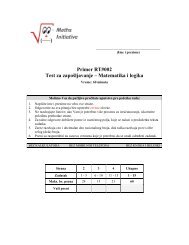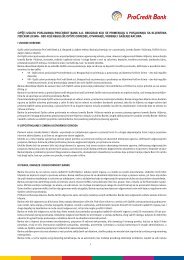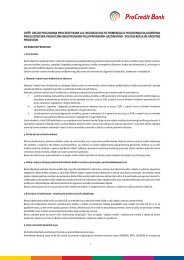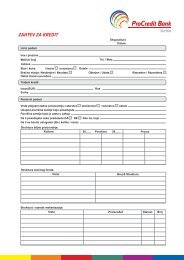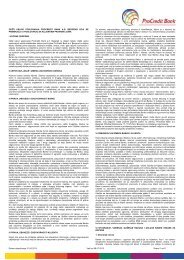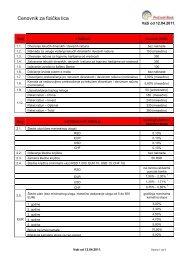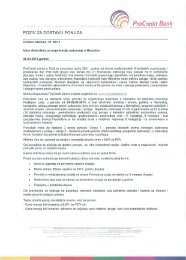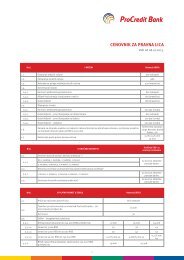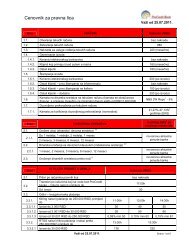Annual Report 2010 - ProCredit Bank
Annual Report 2010 - ProCredit Bank
Annual Report 2010 - ProCredit Bank
- No tags were found...
You also want an ePaper? Increase the reach of your titles
YUMPU automatically turns print PDFs into web optimized ePapers that Google loves.
Financial Statements 57<br />
Y) Comparatives<br />
Where necessary, comparative figures have been reclassified to<br />
conform with changes in presentation in the current year. Reclassifications<br />
in Balance sheet were made.<br />
a) Adjustment of opening balance and comparatives<br />
Balance Sheet Effect on 2008<br />
Property and equipment as at 31 December 2008 2,347,528<br />
Reversal of revaluation (644,439)<br />
Restated Property and equipment as at 31 December 2008 1,703,089<br />
Revaluation reserves as at 31 December 2008 580,993<br />
Reversal of revaluation (579,995)<br />
Restated Revaluation reserves as at 31 December 2008 998<br />
Deferred tax liability as at 31 December 2008 64,444<br />
Reversal of deferred tax (64,444)<br />
Restated Deferred tax liability as at 31 December 2008 –<br />
As at 31 December 2008 the Group performed a revaluation of its<br />
Head Office building in accordance with IAS 16. The Group has recorded<br />
in revaluation reserves within Other comprehensive income<br />
the amount of RSD 579,995 thousand, net of related deferred tax.<br />
In 2009 the Group changed accounting policy and all premises are<br />
stated at historical cost less accumulated depreciation and provision<br />
for impairment, where required.<br />
event as a result of a past event to happen and if the probability is<br />
evaluated to be more than fifty percent, the Group fully provides<br />
for the total amount of the liability. The Group is rather prudent<br />
in these assessments, but due to the high level of uncertainty, in<br />
some cases the evaluation may not prove to be in line with the eventual<br />
outcome of the case.<br />
Z) Critical accounting estimates and judgments<br />
3. Financial risk management<br />
The Group makes estimates and assumptions that affect the reported<br />
amounts of assets and liabilities within the next financial year. Estimates<br />
and judgments are continually evaluated and based on historical<br />
experience and other factors, including expectations of future<br />
events that are believed to be reasonable under the circumstances.<br />
(a) Impairment losses on loans and advances<br />
The Group reviews its loan portfolio to assess impairment at least<br />
on a monthly basis. In determining whether an impairment loss<br />
should be recorded in the income statement, the Group makes<br />
judgments as to whether there is any observable data indicating<br />
that there is a measurable decrease in the estimated future cash<br />
flows from a portfolio of loans before the decrease can be identified<br />
with an individual loan in that portfolio. This evidence may include<br />
observable data indicating that there has been an adverse<br />
change in the payment status of borrowers in a group, or national<br />
or local economic conditions that correlate with defaults on assets<br />
in the group.<br />
Management uses estimates based on historical loss experience<br />
for assets with credit risk characteristics and objective evidence<br />
of impairment similar to those in the portfolio when scheduling<br />
its future cash flows. The methodology and assumptions used for<br />
estimating both the amount and timing of future cash flows are reviewed<br />
regularly to reduce any differences between loss estimates<br />
and actual loss experience.<br />
(b) Provisions<br />
Provisions in general are highly judgmental, especially in the cases<br />
of legal disputes. The Group assesses the probability of an adverse<br />
The Group’s activities are exposed to a variety of financial risks.<br />
This exposure demands organized activities related to analysis,<br />
evaluation, acceptance and management of some degree of risk or<br />
combination of risks. Taking risk is core to the financial business,<br />
and the operational risks are an inevitable consequence of being in<br />
business. The Group’s aim is therefore to achieve an appropriate<br />
balance between risk and return and minimize potential adverse effects<br />
of risks on the Group’s financial performance.<br />
The Group’s risk management procedures are designed to identify<br />
and analyze these risks, to set appropriate risk limits and controls,<br />
and to monitor the risks and adherence to limits by means of reliable<br />
and up-to-date information systems. The Group regularly reviews<br />
its risk management procedures and systems to reflect changes in<br />
markets, products, legislature and emerging best practice.<br />
Risk management is carried out by a Group’s Risk Department<br />
and specialized Risk Committees under procedures approved by<br />
the Board of Directors. The Risk Department identifies, evaluates<br />
financial risks and makes proposals to Risk Committees to hedge<br />
those risks in close co-operation with the Group’s business units.<br />
The Board of Directors provides principles for overall risk management,<br />
as well as written policies covering specific areas, such<br />
as foreign exchange risk, interest rate risk, credit risk, use of derivative<br />
financial instruments and non-derivative financial instruments.<br />
In addition, internal audit is responsible for the independent<br />
review of risk management and the control environment. The<br />
most important types of risk are:<br />
• Credit risk,<br />
• Liquidity and funding risk,<br />
• Market risks (including currency risk, interest rate and other<br />
market price related risks),<br />
• Operational and other risks.


